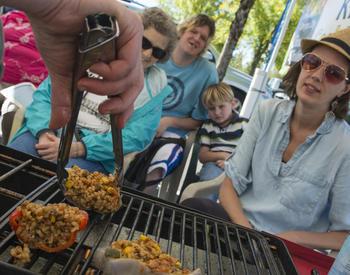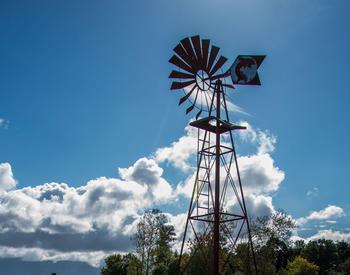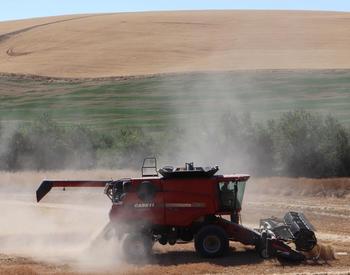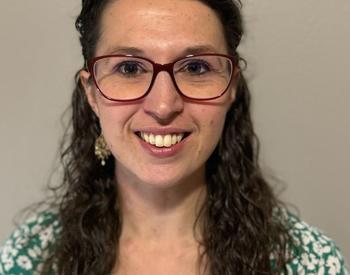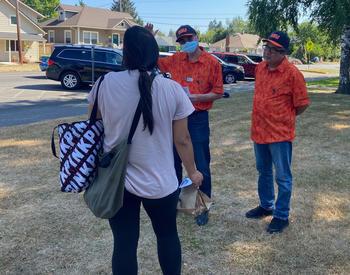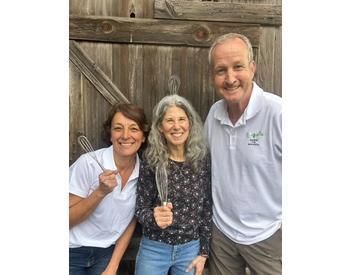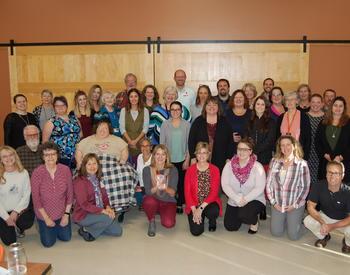ONTARIO, Ore. – Last November, the conference room at the Oregon State University Extension Service office in Malheur County was filled with conversations that had rarely taken place.
The topics were mental health and substance use disorder. The county sheriff was talking to the health department's harm reduction specialist. School counselors were talking to local representatives from the Oregon Department of Human Services.
At the center of the packed conference room were Allison Myers, associate dean with the OSU College of Health and program leader for OSU Extension Family and Community Health; and Barbara Brody, an OSU health Extension associate professor in Malheur County.
It had taken three months for Myers, Brody and a committee of local leaders to bring 47 legislators, health care providers, and educators together in one room. Over the course of two days, OSU Extension staff and local leaders led the group in four structured “Community Conversations” sessions focused on improving prevention and care for people with substance use disorder in Malheur County.
An OSU health Extension team has held similar Community Conversations in five rural counties through the end of 2023, and a sixth is planned for late spring of 2024. Guided by OSU Extension public-health professionals, these discussions have inspired rural counties to collect better data on overdoses, strengthen interagency links, secure millions of dollars in grant funding and create new prevention and treatment services.
From coast to forest
The first of these Community Conversations took place in Tillamook County – though a Zoom room would be more accurate – in September 2021. Dusti Linnell, an OSU Extension associate professor based in Tillamook County, and Abbey Martin, manager of community mental health promotion and substance use prevention at the OSU Center for Health Innovation, helped Myers convene the first group.
The need is acute. Over the past decade, Oregon has repeatedly scored at the bottom of state rankings related to the prevalence of mental illness and treatment rates for substance use disorder. In 2020, OSU Extension received funding from the U.S. Department of Agriculture and the U.S. Substance Abuse and Mental Health Services Administration (SAMHSA) to launch Coast to Forest Oregon, an OSU initiative to promote mental health in rural communities across the state.
“What we represent is a novel, innovative lens on how cooperative Extension programs can be useful for health and well-being,” said Myers, the original lead investigator on the grant. “We’re health educators and community health professionals in every sense of the word. Because of OSU Extension’s legacy in agriculture, forestry and 4-H, we’re trusted in rural areas.”
The framework that the team chose for the six county-wide discussions was SAMHSA’s 2013 “Community Conversations About Mental Health,” which has been shown to effectively lead change efforts at the community level.
Linnell and Martin then adapted the framework to address Oregon's specific needs.
“The guide was designed to promote initial convenings of community members to talk more openly about stigmatizing issues around mental health,” Linnell said. “In Tillamook County and other places in Oregon, we recognized that the audience was actually decision-makers. And they were ready to make decisions and set priorities.”
Going into the 2021 meetings, many participants were concerned whether the conversations might include politically charged debates over COVID-19 shutdowns and vaccinations, the “Defund the Police” movement in larger cities, and the 2020 passage of Oregon's Measure 110, the Drug Addiction Treatment and Recovery Act, which decriminalized possession of small amounts of drugs and promised more funding for behavioral health and recovery services.
OSU Extension professionals were able to play a neutral role in bringing community leaders together, and a sense of shared mission quickly emerged.
“Everybody in the room wanted to see a difference in their community,” Martin said. “They want to see the behavioral health system improved. When there's that common goal, it is more motivating to embrace the conflict and move toward action.”
How the conversations progress
Since the first conversations in Tillamook in 2021, members of Myers’ team have repeated the process in Union, Columbia, Umatilla and Malheur counties. A sixth series in Clatsop County is in the works.
Each time, OSU Extension staff – joined by representatives who work in each community – have begun by convening a local planning team to create the agenda and invite stakeholders to join the discussion.
The Community Conversations protocol starts by sharing experiences. Emergency room doctors may not often get to hear law enforcement officials talk about how the law allows, or doesn't allow, them to respond to mental health crises and overdoses. County legislators may not be aware of the high staff burnout rates among frontline workers.
In subsequent sessions, these interdisciplinary groups map out the existing services and programs in the county, such as housing supports, substance abuse recovery programs, crisis response teams and school prevention programs. Then they identify where the biggest gaps occur.
The final discussion maps out concrete action plans to address those gaps. The group doesn’t just identify priorities but designates specific people or organizations to lead each action item.
Tackling the opioid crisis
Increasingly, the conversations have focused on the statewide surge in opioid overdoses. The discussions in Umatilla and Malheur Counties resulted from a 2022 needs assessment that the OSU Center for Health Innovation conducted in the Oregon Idaho High-Intensity Drug Trafficking Area. In its report, the center recommended fostering “full-spectrum collaborative efforts” such as Community Conversations.
“Our communities are experiencing such tough crises that they’re unable to even think about prevention, because everyone’s just trying to save lives,” Linnell said, adding that treatment and recovery services are underfunded and sparse.
Myers said, “There’s hardly been time to step back and say: ‘How do we work together in a better way?’”
A better way to respond
The Community Conversations have already led to concrete actions in the participating counties. In Union County in northeast Oregon, for example, the discussion group worked with a local media company to record nine radio public service announcements educating people about opioid use and mental health – and then aired those spots over 800 times.
The conversations in Tillamook County helped local agencies strengthen partnerships and raise $3 million in grant funding for projects such as a new emergency shelter and additional peer-support programs.
In Malheur County, Sheriff Travis Johnson says that one of the outcomes of the Community Conversations he helped organize in November 2023 is that his department and the county health department have started sharing the overdose data that each agency has separately collected.
Other action items that have emerged out of the Malheur County conversations, according to Brody, are creating a youth program, establishing a 24-hour crisis stabilization center, and forming an interagency team to respond to the opioid crisis in multidisciplinary ways.
“By leveraging their local knowledge, and acting collectively, the community leaders can effectively address Malheur County's specific needs,” Brody said.
“You can have a meeting, but really the important part is the end result,” Johnson said. “Are you following through? Or did you just talk about it? We continue to meet to try to make a difference in our community.”
Conversations in new communities
Under a new grant from SAMHSA, Martin has begun introducing Community Conversations to rural areas beyond Oregon, in Washington, Idaho and Alaska. In late February, she held the first online webinar to train interested Pacific Northwest facilitators in the protocols OSU Extension developed. Linnell is working with Martin to publish a written facilitators’ toolkit.
“The kinds of challenges our communities are facing around mental illness, substance use disorder and suicide are hard, complicated issues that require a community,” Linnell said. “It’s only through work like this that whole communities can create change.”
